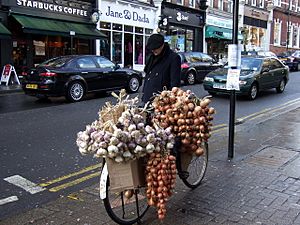Onion Johnny facts for kids

Onion Johnnies (called Sioni Winwns in Welsh) were farmers from Brittany, a region in France. They traveled around Great Britain, especially Wales, selling unique pink onions door-to-door. They often rode bicycles loaded with their onions.
These sellers even gave themselves a nickname in their own language, Breton: ar Johniged or ar Johnniged.
For many years, the Onion Johnnies were a common sight. They wore striped Breton shirts and berets. With their bicycles covered in onions, they became a well-known image of a Frenchman in the United Kingdom. For many British people, the Onion Johnny was their only connection to France.
Contents
The History of Onion Johnnies

The Onion Johnny trade likely started in 1828. A man named Henri Ollivier is thought to have made the first successful trip. These sellers came from an area in Brittany called Bro Rosko, near Roscoff. They found that selling their onions in Britain was more profitable than in France.
Why Britain Was a Good Market
The Johnnies usually brought their onion harvest across the English Channel in July. They would store the onions in rented barns and then return home in December or January. Selling in Paris was an option, but in the 1800s, roads and railways were not good. Traveling to Paris was a long and hard journey. Crossing the Channel to Britain was often shorter and easier.
Onion Johnnies in Wales
Many early Onion Johnnies spoke only Breton. This language is related to Welsh and Cornish. Because of this, Wales was a favorite place for them to visit. They found Welsh much easier to learn than English. The Johnnies who regularly visited Wales became known as Sioni Winwns in Welsh. This name later became "Onion Johnnies" in English.
The Golden Age and Decline
The best time for Onion Johnnies across the UK was in the 1920s. In 1929, almost 1,400 Johnnies brought over 9,000 tonnes of onions to the UK. However, the Great Depression in the early 1930s caused trade to drop sharply. By 1934, fewer than 400 people imported less than 3,000 tonnes.
After World War II, there were rules about importing goods like onions. This also made it harder for the Johnnies to trade. By 1973, their numbers had fallen to 160. By the end of the 20th century, there were only about 20 Onion Johnnies left.
Travel and Dangers
Today, Onion Johnnies travel by ferry. In the past, they used small sailing ships and steamers. These crossings could be dangerous. For example, 70 Johnnies died when the steamer SS Hilda sank near Saint-Malo in 1905.
Onion Johnnies in Culture
In 2004, an Onion Johnny museum opened in Roscoff, France. Every summer, a two-day Onion Festival (Fête de l'Oignon) is held there. Since 2009, the Oignon de Roscoff (Roscoff Onion) has been officially protected under a French quality label. This means it must be grown and produced in a certain way.
See also
 In Spanish: Johnnies para niños
In Spanish: Johnnies para niños

